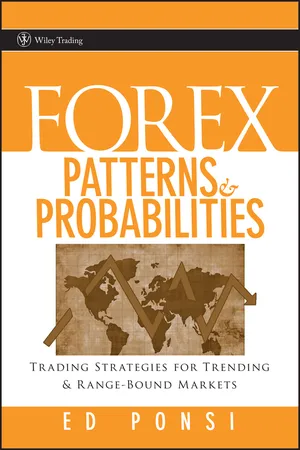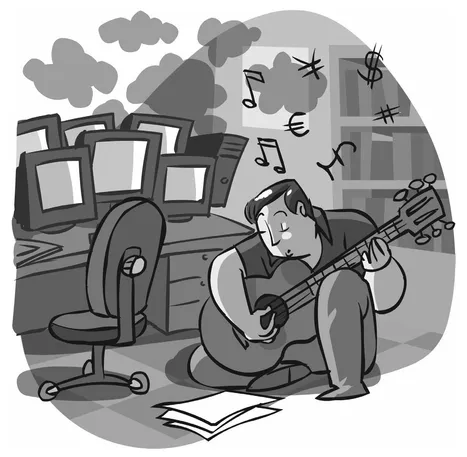![]()
PART I
The World’s Most Dynamic Trading Market
Trading the forex market is one of the most exciting and potentially profitable endeavors that you can undertake. We trade the entire world, matching the world’s economies against one another. This market is vast, much larger than any stock or futures market. There is nothing else like it on earth.
The stakes are high; fortunes can be won or lost quickly. In order to succeed in this realm, we must first learn to understand it. ...
Copyright © 2006 Josep Giró. All rights reserved.
![]()
CHAPTER 1
Getting Started in Forex
Call me Ishmael ...
Just kidding. I’m sure that when anyone is blessed with the task of writing a book, that person secretly (or not so secretly) wishes that it might attain the status of a classic, like Melville’s whaling tale.
You may be an experienced trader, or perhaps you’re just starting out. Either way, remember: Everyone begins at the same starting point. Every trader who ever made money in any market began as a novice. Nobody is born with a deep, innate understanding of trading.
Maybe you believe that superior intelligence is required to succeed at trading. While being bright is not a disadvantage, it is no guarantee of success. Often, very intelligent traders overanalyze trading situations.
Maybe you believe that a good formal education is required to succeed, but this is not the case. What you are about to learn is not taught in any school. Traders learn through study, through trial and error, and through intense analysis of markets, strategies, and techniques. Most of all, traders learn through experience.
Maybe you believe that you must read every trading book you can find. I’ve read dozens of books on trading, most of which are not worth your time. Most of the books that I’ve read contained a kernel of useful information, buried beneath an avalanche of filler. I decided that if I were ever asked to write a book about trading, it would be the antithesis of those books. Instead of performing a sort of “Dance of the Seven Veils,” I’d present an abundance of useful information in a way that most people could understand and appreciate.
My feeling is that the material is useless unless it is explained well, and my goal of helping you to succeed is best served by relating the concepts you are about to study to everyday life. This is a big part of my teaching technique, and you’ll see it demonstrated repeatedly on these pages.
Perhaps you are wondering, “Where should I begin?”
FROM STOCKS TO FOREX
Like most traders in the United States, my first experiences involved stock trading. My first trade, 100 shares in a NASDAQ biotech stock, yielded a small loss.
I was lucky to have started out during the mid-1990s, during one of the most outstanding bull markets in history. In that environment, as long as a trader went with the trend, it was not too difficult to make money. It was a very forgiving market that would bail out even poor traders. The trick was to understand the difference between being good and merely being lucky. Many traders who I believed were talented began to falter when trading conditions became less than ideal. I realized that, like them, I had been a lucky trader, and that luck was transitory. I didn’t want to be lucky; I wanted to become a good trader, one who could make money in any market environment. I wanted to work on Wall Street.
GETTING TO WALL STREET
After sending out dozens of resumes, I was interviewed and hired by a Wall Street firm as a trader. The fact that I didn’t live in New York at the time was a minor detail, and soon I was getting up at around 4:00 A.M. to begin the trek to work.
I would exit my train beneath the World Trade Center, meet up with some coworkers for coffee, and grab copies of the Wall Street Journal and the Investors Business Daily. Once in the office, we would review dozens of charts, discuss recent market tendencies, study economic indicators—in short, we would do everything possible to prepare for the all-out war that would begin every day at 9:30 A.M.
Spending time in the Wall Street environment is an invaluable and irreplaceable experience. There were so many intelligent, driven people, with so much creative energy that you could feel it in the air like static electricity. We lived and breathed trading 24 hours per day, and learned concepts that changed the way we thought about the markets and trading, as well as the world in general. Much of what I learned in this environment would translate well to other trading markets, such as forex, and would become the basis for much of the material in this book.
Eventually, I was lured away by another firm and began working on another trading desk in Manhattan. I moved to New York City, shortening my daily commute from two hours each way to two blocks.
The new trading room was vast, with hundreds of desks and terminals. Having so many traders together, without walls or barriers to separate them, would facilitate the exchange of knowledge and information.
I sought out the best traders and questioned them relentlessly, absorbing and applying the information as quickly as possible. I was introduced to concepts that went far beyond anything I had seen earlier, and the pieces of the puzzle began to fall into place. I began to achieve a level of consistency that had been missing from my earlier trading, which had been profitable but erratic.
WELCOME TO THE JUNGLE
I also learned the disadvantages of trading in this environment, as there were too many people in the room expressing too many ideas and opinions. Essentially, it was a huge room full of ambitious and highly competitive alpha males. Some of the traders had egos that were out of control, and couldn’t help but loudly express every mundane thought that rattled around their skulls. Others would merely express anger and frustration; the distinctive sound of a computer keyboard being smashed, along with the odd tinkling sound of letter keys flying through the air, is etched into my memory.
Jealousy reared its ugly head, as losing traders sought to distract and disrupt the winners. One trader took particular glee in trying to break my concentration, because he felt that my results were making him “look bad.” If he had put as much effort into improving his own trading as he did into disrupting mine, he might have succeeded. He later left the firm to take a sales position.
Eventually, the market reached a point where the easy money had already been made. One by one, the marginal traders began to disappear. The market environment was changing, and traders would have to adapt to the changes or face failure.
FOOTBALL AND FOREX
One of the many benefits of living and working in New York City is exposure to people and cultures from around the world. One of the “new” concepts (at least it was new to me) to which I was exposed at this time was the currency market.
It was shocking to learn that foreign exchange trading, or forex, was tremendously popular in the rest of the world, and had been for many years. For most of the world, the forex market, not the stock market, is the market to trade. You could compare forex to football, which is the world’s most popular sport—except in the United States, where it is considerably less popular and is referred to as “soccer.” Here was a trading market that enjoyed wide popularity overseas, yet at the time it was “off the radar” in the United States.
A trader friend told me that he had decided to quit stock trading and instead switch to currencies, and that my style of trading would be perfectly suited to this new endeavor. I laughed, not knowing that soon I would make a similar move. Why on earth would I ever want to give up trading stocks?
STOCK MARKET HEADACHES
In life, there are certain unpleasantries with which we must learn to deal. We have to go to school, pay our bills, watch our weight, and so on. We accept these unpleasantries with thoughts such as “deal with it” or “that’s life.” After a while, we no longer think of these things as a burden; instead, they become the norm.
For equity traders, there are many unpleasant situations that are considered to be normal, just “part of the game.” Stock traders don’t think twice about these situations, because they are an ingrained part of their daily lives.
Partial Fills
For example, the “partial fill” is a normal occurrence in stock trading. A partial fill occurs when a trader places an order for a certain number of shares, let’s say for 2,000 shares of stock, and instead receives only a portion of the order, for example, 300 shares. This happens all the time; the most logical explanation is that perhaps there were only 300 shares available at that particular price.
In trading terminology, we say that the market is too “thin” to absorb the entire order, meaning that there are not enough shares available at that price. This can be really frustrating, especi...

